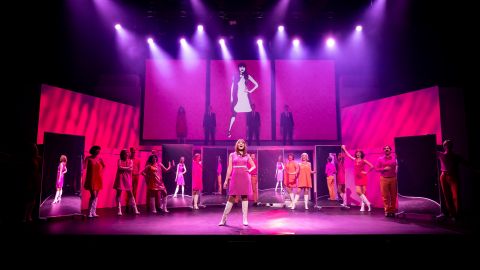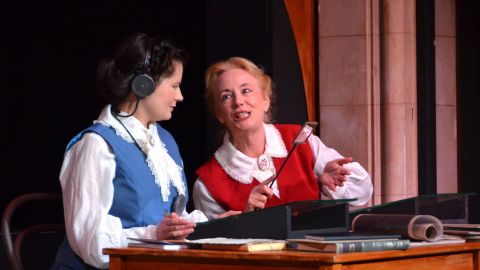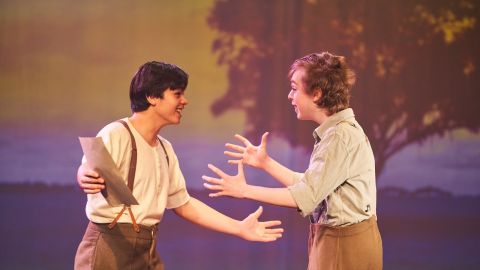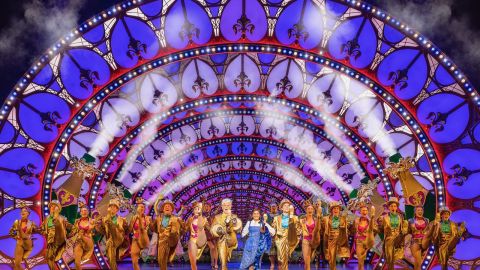Director’s Diary: Ladies in Black
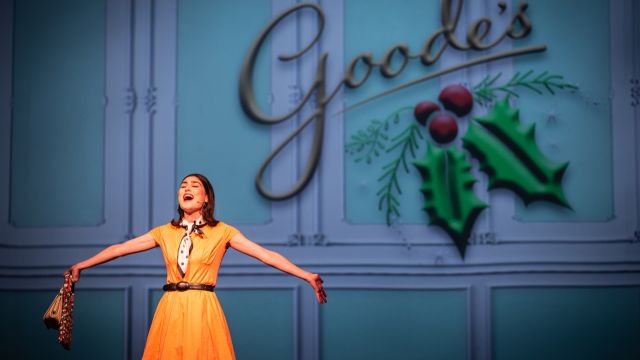
Cathy Boyle took charge of Strathfield Musical Society’s NSW Amateur Premiere of Ladies in Black.
I can still remember the QTC production of Ladies in Black which I saw at the Sydney Lyric Theatre. I loved the gorgeous 50’s styling, was envious of the magnificent revolve that wafted scenes on and off the stage, found Tim Finn’s music absolutely approachable and loved the idea of doubling a number of the roles. At interval, I said to my friends “I am really loving this, what about you?” They just replied “Oh yes!” Our opinions didn’t change during Act 2, where we all soaked up the happy endings that abounded in this gentle, charming musical.
When I saw that David Spicer had obtained the rights to this show, I was really keen to do it - but which society would take a risk on this new musical? The short answer is – Strathfield Musical Society. And how very grateful I was!
The format I eventually decided on for Ladies in Black was very different from what I had seen and loved. Roles were not doubled, the revolve was not going to be included (although to be fair I wasn’t really expecting to use one on Strathfield’s stage) and offstage “voices” from the QTC production would become an ensemble as citizens of Sydney in all their various guises.
My staging was a simple one – three large ascending rostra that would become multi-use acting areas. Some items of furniture rolled on and off but much of the store furniture lived permanently at the edge of the rostra, very often shrouded in the cream colour that made up the palette of the stage.
I think that all of that cream would have been very boring, except for the beautiful projections designed by Adam Ring and Chae Rogan. The projections not only represented all the locations in the story (and believe me – there are LOTS of locations!) but were able to help delineate the many multi-scene moments of the show. Every projection added something to the show. I was thrilled when a row of designer gowns appeared behind Magda (Tisha Kelemen) as she sang “Model Gowns”.
Whenever you use projections in shows, you need a very sympathetic lighting designer and I was fortunate to have Gints Karklins. The haze that often creates beautiful and complex lighting effects had to be toned down to minimal levels; the items of furniture that lived permanently onstage created difficulties with the side lighting that can make beautiful patterns; tiny areas of the stage needed to be lit whilst scenes were being set up in other dark areas and of course, there could be no strong lights towards the back of the stage.

One of the aspects of the QTC show I wanted to keep was that of the beautiful 50’s styling and I had Sharon Palmer as Costume Co-ordinator and Angela Mosley as Props Co-ordinator.
We scoured online retro clothing sites and Sharon purchased and made an enormous number of costumes. Not only were there many, many bodies to be clothed in a variety of scenes but there were also racks of clothes that were never worn but hung on the store racks of Goode’s Department Store. Many of the cast had also been entranced by the prospect of wearing delectable 50’s clothes and offered some of their own clothes either for themselves or as display models.
Props were also very important to sustain the feel of the 50’s. I had my first, rather addictive, experience with Facebook marketplace and we were able to source some lovely authentically styled furniture. I think my favourite was the emerald green formica topped table with matching chairs. We also had authentic, correctly dated Women’s Weekly magazines and newspapers, Mum’s sewing box was exactly like the one I remembered from my childhood and our beach scene was full of lovely details like binoculars, folding chairs, picnic baskets and towels. Angela’s advice to always ask the cast was very wise indeed.
Tim Finn’s music was simple and conversational for the major part of the show and my singers were able to manage it very nicely – thanks to Elisabetta Sonego, my Musical Director. However, there were a number of pieces where quite complex rhythms had to be mastered: two that spring to mind are “Sales Talk” and “Pandemonium”, where shop assistants and customers either spoke over each other or had to pick up another line of their song as another singer was still finishing their line. My performers struggled with the fact that only a few of the songs were available to listen to and these were not the tricky numbers. A cast recording would have been a great help to us in the early stages. We were glad that we had allocated regular revision sessions for the complex numbers.
Probably the most important aspect of this show was the cast. We had many talented women audition – probably we could have double cast a number of roles - but the truly problematic role was Lesley Miles. Supposedly a sixteen-year-old, thin, shy bookworm, this actor is the lynchpin of the show. Fortunately for us, Isobel Lim appeared at the final session of auditions and we were in safe hands - but it is a really tough role to cast. There was also a difficulty in getting men to be interested in the show – they just didn’t know that there were beautiful, character-driven roles for them. Fortunately, again, the critical people appeared at auditions. I have never felt that an orientation evening had been so worthwhile!
 My cast was very patient as I talked to them about their characters, quoting from the novel or even the film. I’m sure their hearts sank as I appeared at rehearsals with even more post-it notes in my copy of the novel! The fact that so few either knew the novel or had even seen the musical meant that we spent longer than normal developing our understandings of what was happening in these people’s lives. It was time well spent. I think that as show time approached, we felt we had fleshed out these lovely people and could present something that was honest and true to life.
My cast was very patient as I talked to them about their characters, quoting from the novel or even the film. I’m sure their hearts sank as I appeared at rehearsals with even more post-it notes in my copy of the novel! The fact that so few either knew the novel or had even seen the musical meant that we spent longer than normal developing our understandings of what was happening in these people’s lives. It was time well spent. I think that as show time approached, we felt we had fleshed out these lovely people and could present something that was honest and true to life.
So, what were the pros and cons of doing a new musical? One huge positive for me was that I was able to work with my team to really create something. So often in musicals you are re-creating or trying to satisfy audience expectations about what the show should be like. We felt we had an almost blank canvas and that was exciting.
One difficulty with all that freedom is that lots of time is required and lots of talking has to happen so that everybody involved is clear about the destination. We had a long rehearsal period and I think that I probably spent two or three times as long as I normally do in mulling over characters and events.
There weren’t the resources that are available for most musicals and that sometimes made our progress quite slow. A wonderful woman from Western Australia (Kimberley Shaw) started a Facebook group for those of us who were planning to present the show and that was great. We chatted and were able to solve a couple of the dilemmas presented in the script and score.
Would I do a new show again? Absolutely! I would need a team as dedicated as the one I had for Ladies in Black and I would hope the stars would align as beautifully as they did for us - but it is possible. And when it works, it is immensely satisfying!
Photographer: Haydn Allbutt
Originally published in the July / August 2019 edition of Stage Whispers


